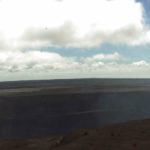Hawaiian Volcano Observatory scientists provided a Kilauea Volcano eruption update as of Thursday morning, Dec. 31, 2020, at 8 a.m.:
KĪLAUEA VOLCANO (VNUM #332010)
19°25’16” N 155°17’13” W, Summit Elevation 4091 ft (1247 m)
Current Volcano Alert Level: WATCH
Current Aviation Color Code: ORANGE
Activity Summary: Lava activity is confined to Halemaʻumaʻu with lava erupting from vents on the northwest side of the crater. Over the past 24 hours, the lava lake depth measurements have ranged from 181 m to 185 m (593 to 608 ft) deep with a narrow black ledge around it. Reduced, but still elevated, SO2 emissions were measured Monday (Dec. 30).
Summit Observations: Preliminary analysis of sulfur dioxide emission rates measured Wednesday (Dec. 30) show that the rates are about 3,800 tonnes/day– about the same as on the 28th and slightly lower than the Dec. 27 rate of 5,500 t/d, but still elevated; all three of the most recent emission rates were in the range of values common for the pre-2018 lava lake. Summit tiltmeters recorded neither inflationary nor deflationary tilt over the past two days. Seismicity remained elevated but stable, with steady elevated tremor and a few minor earthquakes.
East Rift Zone Observations: Geodetic monitors indicate that the upper portion of the East Rift Zone (between the summit and Puʻu ʻŌʻō) contracted while the summit deflated. There is no seismic or deformation data to indicate that magma is moving into either of Kīlauea’s rift zones.
Halemaʻumaʻu lava lake Observations: The west vents spattered while erupting lava flowed through crusted-over channels into a lava lake within Halemaʻumaʻu crater.
The lava lake within Halemaʻumaʻu crater continued to enlarge slowly in the past few days. The lake depth measurements over the past 24 hrs have ranged from 181 to 185 m (593 to 608 ft) deep; the most recent measurements late last night (Dec. 30) and early this morning (Dec. 31) were made in extremely windy conditions and may not be as accurate as earlier measurements made in calmer conditions. The most recent thermal map (Dec. 30) provided the lake dimensions as 800 by 530 m (875 by 580 yds) for a total area of 33 ha (82 acres). The narrow (10-30 m or 11-22 yd) ledge around the lake was about 1-2 m (1-2 yds) above the active lake surface (https://www.usgs.gov/maps/december-30-2020-k-lauea-summit-eruption-thermal-map).
Over the past day, the main island of cooler, solidified lava floating in the lava lake continued to drift slowly to the west while the other 10 or so small islands stayed put around the east end of the lake. The main island measured about 250 m (820 ft) in length, 135 m (440 ft) in width, and about 3 ha (7 acres) in area based on the Dec. 30 thermal map. Measurements yesterday evening (Dec. 30) show that the island surface was about 6-8 m (20-26 ft) above the lake surface.
Near-real time webcam views of the lava lake can be found here: https://volcanoes.usgs.gov/volcanoes/kilauea/multimedia_webcams.html.
Hazard Analysis: High levels of volcanic gas, rockfalls, explosions, and volcanic glass particles are the primary hazards of concern regarding this new activity at Kīlauea’s summit. Large amounts of volcanic gas—primarily water vapor (H2O), carbon dioxide (CO2), and sulfur dioxide (SO2)—are continuously released during eruptions of Kīlauea Volcano. As SO2 is released from the summit during this new eruption, it will react in the atmosphere with oxygen, sunlight, moisture, and other gases and particles, and within hours to days, convert to fine particles. The particles scatter sunlight and cause the visible haze that has been observed downwind of Kīlauea, known as vog (volcanic smog), during previous summit eruptions. Vog creates the potential for airborne health hazards to residents and visitors, damages agricultural crops and other plants, and affects livestock operations. Rockfalls and minor explosions, such as the ones that occurred during the 2008–2018 lava lake eruption at Kīlauea summit, may occur suddenly and without warning. This underscores the extremely hazardous nature of Kīlauea caldera rim surrounding Halemaʻumaʻu crater, an area that has been closed to the public since late 2007. Pele’s hair and other lightweight volcanic glass fragments from the lava fountains within Halemaʻumaʻu will fall downwind of the fissure vents and lava lake, dusting the ground within a few hundred meters (yards) of the vent. High winds may waft lighter particles to greater distances. Residents are urged to minimize exposure to these volcanic particles, which can cause skin and eye irritation similar to volcanic ash.
Vog information can be found at https://vog.ivhhn.org/.
Photo from webcam located at the Hawaiian Volcano Observatory observation tower, which is still near the rim of the caldera, on Dec. 31, 2020, around noon. Click on photo to enlarge.
